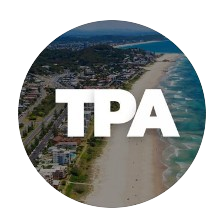
Aboriginal History and Heritage
When the Gold Coast was first settled, there were several distinct clan estate groups living between the Tweed and Logan Rivers and bounded to the west by Beaudesert. Collectively, they were known as Yugambeh people and spoke the Yugambeh language. There is evidence of several distinct dialects being spoken in the region.
The name ‘Tugun’ is believed to be derived from the Aboriginal word ‘Jungen’ for ‘breaking waves’.
More information about the history of the Yugambeh people can be found on www.yugambeh.com.
First European Settlement
In 1898, the pioneering Farrell family trekked overland from the township of Tallebudgera along a track (now Simpsons Road) to their selection of land just south of Currumbin Hill. They established a camp site and began to clear the land for a home and grazing paddocks for their small herd of dairy cattle. Their selection and slab home was the only farming property in the area south of Currumbin for many years. The local Aboriginal people bartered with the Farrells for fish and crabs supplementing the settlers’ diet when times were lean.
North-west of Currumbin Hill and over the creek (now Flat Rock Creek), the Mitchell family settled on their block, a few weeks after the Farrell family. Initially, there was some rivalry between the two families based on old country loyalties (the Farrells were from Southern Ireland and the Mitchells were from the north). However, years spent together as pioneers of this settlement and the experience of isolation for both families, let them to become the firmest of friends.
The completion of the railway north from Nerang to Tweed Heads in 1903 opened the area south of Currumbin to many new settlers. The railway line was the making of Coolangatta and brought many holiday makers to the seaside resort. It also opened up an economic link to the Capital City of Brisbane. The rail line enabled dairy farmers (in the Currumbin area) to send their cream to the butter factories located at the end of the line in Tweed Heads.
In 1910, the Lands Department and the Post Master General agreed to name Tugun as an official place. Around 1913, the Farrell family applied for a rail stop which would allow them to load their produce on the train. The siding was known for some time as the 65 mile 46 chain stop (the distance from South Brisbane station). The rail stop then bccame known as Tugun. Crown land was sub-divided into allotments and put up for auction after 1915. A year later, the first home was built in Tugun Village.
The construction of a costal road linking Southport to Coolangatta in the 1920s was a major achievement for the area. The age of the mass-produced motor car provided the impetus for developing beach properties and accommodation facilities in Tugun and Bilinga.
The Seaside Hotel was constructed in Tugun in 1925 and boasted facilities including a first class septic system and electricity. The Diamond family took over the hotel in 1926. Unfortunately, the hotel burnt to the ground a short time later and Paddi Diamond purchased the site and rebuilt the hotel. Along with other properties in the village, the Tugun Hotel has undergone many changes over the years and survives today as a popular landmark..






History of the Tugun Progress Association (TPA)
In 1931, following joint efforts with Bilinga, Currumbin and Palm Beach to lobby the Gold Coast City Council for better facilities, Tugun formed its own community progress association.
The first annual meeting was held on the 27th July 1931. At a public meeting in 1952, the idea of building a hall for th village was raised and fundraising began in earnest. The land on which the hall was built was gazetted ‘Public Reserve for Community Purposes’ in 1947.
The building of the hall began in 1963, with money raised by the local community. Most of the construction was undertaken by volunteers and a few specialist trades. it was officially opened in April 1968. The Gold Coast City Council donated the original stage curtains and chairs.
During the early years, the TPA was very active in obtaining better facilities for the rapidly growing village of Tugun, including street lighting and drainage. The TPA played a crucial role in ensuring the southern Gold Coast received the appropriate planning and infrastructure. The association continues to lobby the Gold Coast City Council on behalf of the community of Tugun.
The TPA proudly sported the re-establishment of a bank in Tugun – The Tugun Community Bank Branch Bendigo Bank – which has now been operating in the village for thirteen years – the only bank with a visible presence in the village.
The Tugun bypass and village centre upgrade are other important projects successfully supported and encouraged by the TPA.
The TPA continues to represent the community on a number of issues, including the Airport Noise Abatement Consultative Committee and the extension of the Leith rail system for the Gold Coast.



